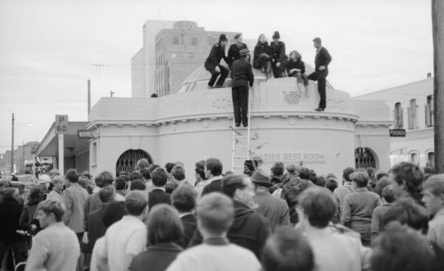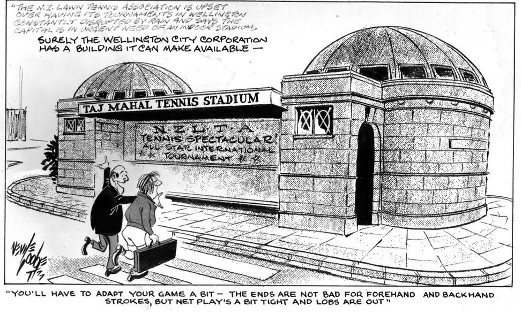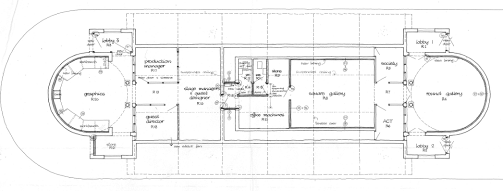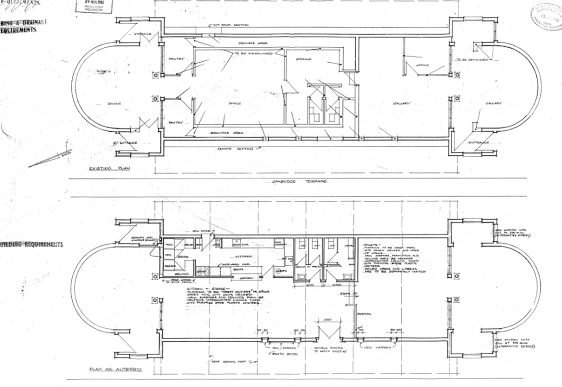Public Conveniences (Former, ‘Taj Mahal’)
The Welsh Dragon Bar and Scorpio’s Restaurant, The Taj Mahal, Public Convenience

Photo: WCC - Charles Collins, 2015


National Library reference: Kent Terrace and Oriental Parade, Wellington. Ref: 1/2-116556-F. Alexander Turnbull Library, Wellington, New Zealand. http://natlib.govt.nz/records/22838426


Victoria University students taking part in a capping stunt, on the roof of the "Taj Mahal", Courtenay Place, Wellington, watched by a large crowd. Police are climbing the roof on ladders to arrest the students. Photograph taken 3 May 1967 by an Evening Post staff photographer.
National Library reference: Victoria University students on roof of Taj Mahal, Courtenay Place, Wellington. Further negatives of the Evening Post newspaper. Ref: EP/1967/2436/29A-F. Alexander Turnbull Library, Wellington, New Zealand.
http://natlib.govt.nz/records/23199078
National Library reference: Lodge, Nevile Sidney, 1918-1989. Lodge, Nevile Sidney, 1918-1989 :"You'll have to adapt your game a bit - the ends are not bad for forehand and backhand strokes, but net play's a bit tight and lobs are out". [19]77.. Ref: A-341-048. Alexander Turnbull Library, Wellington, New Zealand.
http://natlib.govt.nz/records/23229732

-
Constructed
1928 - 1928
-
Heritage Area
-
Architect(s)
-
Builder(s)
Fletcher Construction Ltd.
-
A single-storey building built as a simple Raj-influenced, stripped classical building. The domes and decorative scheme are an unusual and whimsical addition to what was a public convenience for tram staff and passengers until 1964.
Affectionately known as ‘the Taj’, it was threatened with demolition in 1964 and saved following a public campaign. In 1978 it opened as a teashop and gallery and it now houses The Welsh Dragon Bar.
-
Downloadable(s)
-
close
History
-
The building was designed in 1928 by architects at the Wellington City Engineers Office as a public convenience for the employees and passengers of the tramways and also the wider Wellington community. Unlike other public conveniences built at the time, this building was constructed above ground, and was part of a series of interesting public utilities designed by the Wellington City Corporation. Due to its functional use and quirky design the building quickly became a Wellington landmark known by the nickname ‘Taj Mahal’.
The toilets were used for their original purpose until 1964, when they were temporarily closed due to high maintenance, running costs, increasing inaccessibility due to heavy traffic and low use by the public. The council decided it would be more economical to build new public toilets in Courtenay Place than to upgrade the existing building. It is a testament to the high esteem that Wellingtonians had for the old building, that when the public became aware of the Council’s plan to demolish the building, many wrote to the newspapers arguing against the plan.
The building was briefly reopened, but usage of the public convenience was proven to have dropped and in 1966 the Council felt justified in closing the toilets permanently. A variety of groups applied for use of the building. Ideas included: removal and reconstruction as part of a museum complex at Paraparaumu, a craft centre, two gauge model railway, begonia house, community centre and a training centre for the Girl Guide Movement.
The successful applicant for the use of the space was Downstage Theatre Company, newly founded in 1964, which required the space for storage of theatrical props and paraphernalia. In 1971 it was leased to the Hannah Playhouse (home to Downstage Theatre) as a workshop and gallery. Downstage spent approximately $16,500 on interior alterations, including moving interior walls to create larger spaces.
The building is held in high public esteem by Wellingtonians. Stephen Oliver wrote a ‘The Ballad of the Taj Mahal’, a ribald ditty describing the building’s changing fortunes. In 1967 the building’s roof was a surprising choice for high jinks associated with the capping ceremony when Victoria University students, staged a ‘prayer-in’ on the roof of the Taj Mahal.
Despite the work carried out by Downstage to make the building more suitable, the space was very hot in summer and very cold in winter. Crossing the road from the Taj Mahal to the Downstage Theatre at night was a dangerous proposition – at least one actress was stuck by a passing motorcyclist. A combination of these concerns persuaded the Downstage to find storage space elsewhere and the building fell into an ‘appalling state of disrepair’.
In 1978 it was given a new lease of life when it opened as a teashop and gallery. Considerable work was undertaken to convert it for hospitality use. The interior gallery was painted green and pink and works by New Zealand artists featured on the walls.
In 1980/81 a mural was painted on the ceiling of the interior. Inspiration for the design came from occupant C. Cass, who envisaged something similar to the Sistine Chapel, but based around the theme of politicians of the day. Politicians depicted include Holyoake, Seddon, Fraser, Nash, Holland, Nordmeyer, Mabel Howard, Muldoon and Lange. The mural was painted by artists David Waterman and Terry Archer. The cafe operated until 1982. The building continued to be used in hospitality when, in 1997, it opened as ‘The Dome’ Restaurant and Bar. Today the building is home to The Welsh Dragon Bar and Scorpio’s Restaurant but Wellingtonians still recall when the building was, as one commentator put it, ‘the fondest inconvenient convenience in the land’.
-
Modifications
close
-
1928
-
Building constructed. (00205:14:1343 and 00056:61:B5832)
-
1936
-
Dome roof repaired.
-
1951
-
Verandahs covered, work to make leaking roof weather-tight.
-
1952
-
Leaking skylight repaired. (00009:1567:11/5/2)
-
1954
-
Roof painted in advance of the royal visit and procession. (00009:1567:11/5/2)
-
1955
-
All 32 windows in domes replaced (replaced with copper radix glazing bars and wire cast skylight glass and necessary flashings). (00009:1567:11/5/2)
-
1957
-
Renewal in copper of existing glazing bars and glass and flashing same in copper, reconstruction where necessary of timber in glazing bar area. (00009:1567:11/5/2)
-
1958
-
Replace malthoid portion of main roof with corrugated copper, cap flash parapets with sheet copper, recover verandahs on east/west walls with fibre glass. (00009:1567:11/5/2)
-
1973
-
Downstage Theatre converted building to use it for offices, a design room and theatre exhibition area. (00058:873:C38816)
-
1982
-
Alterations to building approved, carried out under building permit. (00058:0:C60876)
-
1996
-
Neon sign installed. (00078:4:20313)
-
1999
-
Refit of the kitchen and bar area. (00078:216:51792)
-
unknown
-
Alterations for Dome Restaurant, 1999. 51792
-
-
Occupation History
close
-
1928
-
– Wellington City Council
-
1971
-
Leased to the Hannah Playhouse (Downstage Theatre) as a workshop.
-
1978
-
– Tea shop and gallery.
-
1982
-
– Taj Mahal Café and Gallery.
-
1997
-
- ‘The Dome’ Restaurant and Bar.
-
unknown
-
Today the building is occupied by the Scorpios Restaurant and Welsh Dragon Bar. (2012)
-
-
-
close
Architectural Information
-
Building Classification(s)
close
Not assessed
-
Architecture
close
This small single storey building is distinctive for its simple Raj-influenced Stripped Classical decoration. It has semi-circular ends, two domes – at either end – and stripped Classical design motifs which include a bracketed cornice and steeped roof parapet.
When built, there was a women’s rest room under the dome at the north end with wash areas and toilets in the body of the building, while the men’s toilets, with a semi-circular row of urinals under the dome, occupied the south end. This arrangement was changed long ago and the internal arrangements greatly altered. Today the principal spaces are occupied by a bar, restaurant and kitchen, with new partitions and fittings. The northern end of the building is obscured by a fenced enclosure.
-
Materials
close
Rendered reinforced concrete. Tiled mosaic floor covering. Malthoid roof covering.
-
Setting
close
The former ‘Taj Mahal’ public convenience’s exotic appearance and general profile is is strongly enhanced by its unusual location on the narrow median strip between two wide and very busy roads, Kent and Cambridge Terraces. It is a highly visible building (although somewhat less so than when it was a toilet because of a fenced enclosure and landscaping on its northern end). Furthermore, it is located right on the edge of the intersection with Courtenay Place and Majoribanks Street, where a number of significant heritage buildings are located on key corners, including the Hannah Playhouse on Cambridge Terrace, and the Clemenger BBDO Building and the Embassy Theatre, both on Kent Terrace.
Cambridge Terrace, between Wakefield Street and Courtenay Place contains an important cluster of pre-1930s buildings (excepting the Hannah Playhouse and the modern YHA Building) that add much to the historic and architectural character of the area.
-
Building Classification(s)
close
-
close
Cultural Value
Built in 1928, the Taj Mahal is a small, single storey building constructed as a simple Raj-influenced, stripped Classical building. The domes and decorative scheme are an unusual and whimsical addition to an otherwise utilitarian building that was originally designed as a public convenience for tram staff and passengers.
The building is a Wellington landmark, in part for its unusual design, and in part for its location in the centre of a busy transport route along Cambridge Terrace. The building makes a singular contribution to the streetscape of Cambridge Terrace and the Courtenay Place Heritage Area.
Affectionately known as ‘the Taj’, this building is held in high public esteem. This was demonstrated by the public campaign to save the building when it was threatened with demolition in 1964, and by the various references to the building in popular culture over the years.
-
Aesthetic Value
close
-
Architectural
Does the item have architectural or artistic value for characteristics that may include its design, style, era, form, scale, materials, colour, texture, patina of age, quality of space, craftsmanship, smells, and sounds?
The Taj Mahal is a small, single storey building constructed as a simple Raj-influenced, stripped Classical building. The domes and decorative scheme are an unusual and whimsical addition to an otherwise utilitarian building.
-
Group
Is the item part of a group of buildings, structures, or sites that taken together have coherence because of their age, history, style, scale, materials, or use?
The building is one of a group of public utilities designed in a quirky and unconventional style by the Wellington city engineer’s department in the 1920s.
The building is also part the Courtenay Place Heritage Area, a mostly continuous heritage landscape of buildings constructed in the first half of the 20th century, although there are significant differences in form and style between some of the buildings.
-
Townscape
Does the item have townscape value for the part it plays in defining a space or street; providing visual interest; its role as a landmark; or the contribution it makes to the character and sense of place of Wellington?
The building is a Wellington landmark, in part for the whimsy of its design, and in part for its location in the centre of a busy transport route along Cambridge Terrace.
The building makes a positive contribution to the streetscape of Cambridge and Kent Terraces and the Courtenay Place Heritage Area (which extends to include this building).
-
-
Historic Value
close
-
Association
Is the item associated with an important historic event, theme, pattern, phase, or activity?
The building has a historic association with the tram service that ran in Wellington until 1964.
-
Association
Is the item associated with an important person, group, or organisation?
The building is an example of the key role played by the Wellington City Council in providing important public utilities.
-
- Scientific Value close
-
Social Value
close
-
Identity Sense Of Place Continuity
Is the item a focus of community, regional, or national identity? Does the item contribute to sense of place or continuity?
The building has occupied its present site since 1928 and, being such a visible structure, it contributes strongly to the sense of place and continuity of the Courtenay Place Heritage Area.
-
Public Esteem
Is the item held in high public esteem?
Affectionately known as the Taj Mahal, this building is held in high public esteem. This was demonstrated by the public campaign to save the building when it was threatened with demolition in 1964, and by the various references to the building in popular culture (for example in cartoons, as a backdrop to student capping stunts) over the years.
-
SentimentConnection
Is the item a focus of community sentiment and connection?
There is considerable affection for this building despite the loss of its original function. In its role as a bar/restaurant, it remains open to the public and it is still well patronised. Strong public support to keep the building in the past reveals the depth of its appeal.
-
-
Level of Cultural Heritage Significance
close
-
Authentic
Does the item have authenticity or integrity because it retains significant fabric from the time of its construction or from later periods when important additions or modifications were carried out?
The building exterior is relatively unaltered and retains most of the original building fabric.
-
Rare
Is the item rare, unique, unusual, seminal, influential, or outstanding?
The building is rare because it resembles no other building in Wellington, or, in all likelihood, New Zealand.
-
Importance
Is the item important for any of the above characteristics at a local, regional, national, or international level?
The ‘Taj Mahal’ has to be one of the country’s most interesting former public toilets or public utility of any kind, and is of local importance for its contribution to the Courtenay Place Heritage Area.
-
-
Local / Regional / National / International Importance
close
Not assessed
-
Aesthetic Value
close
-
close
Site Detail
-
District Plan Number
16/ 56
-
Legal Description
Legal Road
-
Heritage New Zealand Listed
2/Historic Place 1434
-
Archaeological Site
Central City NZAA R27/270
-
Current Uses
unknown
-
Former Uses
unknown
-
Has building been funded
No
-
Funding Amount
Not applicable
-
Earthquake Prone Status
Not Earthquake Prone
-
-
close
Additional Information
-
Sources
close
- Kelly, Michael and Russell Murray, Wellington City Council, Courtenay Place Heritage Area Report. Welllington City Council: Unpublished report, prepared for Plan Change 48, 2006.
- NZ Historic Places Trust Buildings Field Record Form, “Taj Mahal Restaurant”, No1434.
- Stoks, Francis G. The Taj Mahal: Some Historical Notes, unpublished report, Oct 1978.
- Wellington City Council, Courtenay Place Heritage Area spreadsheet. Wellington City Council: Unpublished report, prepared for Plan Change 48, 2006.
- Wellington City Council, Wellington Heritage Building Inventory 1995. Wellington City Council, 1995.
- Wellington City Council, Wellington Heritage Building Inventory 2001: Non-Residential Buildings. Wellington City Council, 2001.
- Wellington City Council Records
- “Heritage Building – Cambridge/Kent Terrace – Taj Mahal”. 2003. 1041-06-CAM Vol 1, Wellington City Council Records.
- Archives: “Conveniences, Courtenay Place [Cambridge Terrace]”, 1928, 00205:14:1343, Welington City Archives.
- Archives: “Cambridge Terrace, men's convenience”, 20 Jan 1928, 00056:61:B5832, Wellington City Archives.
- Archives: “Kent Terrace, Cambridge Terrace, alterations”, 19 Sep 1973, 00058:873:C38816, Wellington City Archives.
- Archives: “Cambridge Terrace, additions and alterations”, 13 Dec 1982, 00058:0:C60876, Wellington City Archives.
- Archives: “Cambridge Terrace, install neon sign”, 05 Jul 1996, 00078:4:20313, Wellington City Archives.
- Archives: “Cambridge Terrace, additions and alterations”, 1999, 00078:216:51792, Wellington City Archives.
- Technical Documentation close
-
Footnotes
close
Not available
-
Sources
close
Last updated: 4/20/2017 3:45:28 AM
